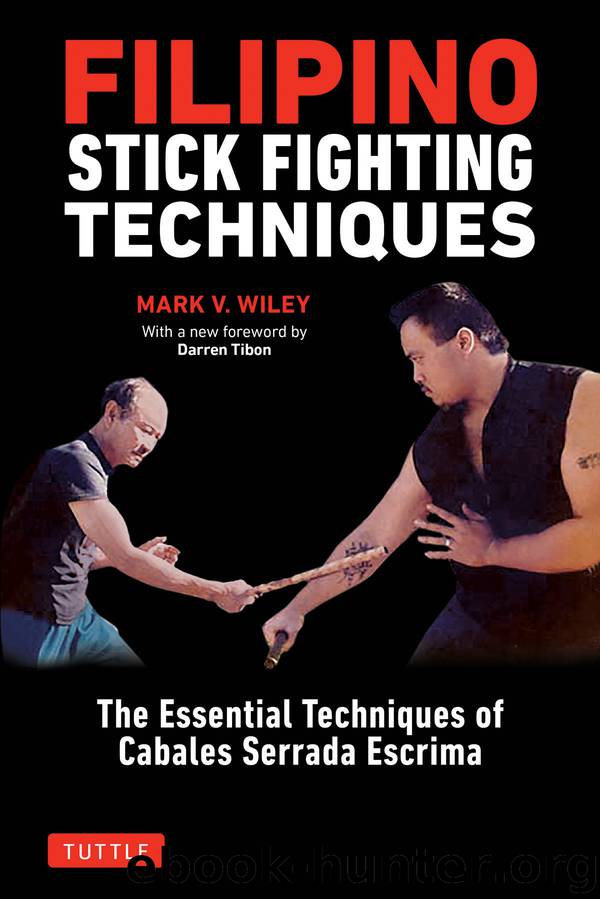Filipino Stick Fighting Techniques by Mark V. Wiley

Author:Mark V. Wiley
Language: eng
Format: epub
Publisher: Tuttle Publishing
Controlling Distance
Aside from strong fundamentals, one of the most important things an escrimador must develop is the ability to control distance and movement—both his and his opponent’s. In terms of escrima, there are generally three defined critical distances, or combat ranges that all techniques are said to fall within. It is within these distances that certain techniques may be employed more effectively than others. It is also the ability to control these distances, or fighting ranges, that determines the victor of a bout.
A critical distance can be defined as any distance that has the ability to form a crisis, or threatening situation. In escrima this refers to any distance from which your opponent can strike you with edged, impact, or anatomical weapons. Offensive as well as defensive strategies must be understood, developed, and mastered in each of the three ranges in order for one to truly understand the art. Moreover, the concept of distancing, or combat ranges, must be understood because there is no set numerical distance between each range, or between opponents when in a particular range.
THE CONCEPT OF COMBAT RANGES
Combat ranges in escrima are divided into long, medium, and close, and are those distances between opponents that at once affect and determine the effectiveness of one technique over another. When developing an appreciation of combat ranges in general, it is essential to understand that they are not predetermined but relative. In other words, one cannot say for sure, for example, that “long range” is a distance of 4 feet from an opponent. Rather, the critical distance of each range is determined by the height of both opponents and length of their respective weapons.
Combat ranges, then, are not “set” but conceptual, and determined by such factors as the relative height of the opponents, the length of their arms, and the relationship of both typology and length of the weapons they employ. Moreover, and depending on these characteristics, it is improbable that you and your opponent will ever be in the same range at the same time. In other words, while you are in medium range, depending on the physical characteristics of your opponent and both of your weapons, your opponent might actually be in long or close range.
Let’s now look at each of the three general ranges more closely.
Long Range
Long range is generally determined as that distance between you and your opponent wherein you can effectively strike your opponent’s body with your weapon at full extension of your arm, but you are too far away to check his weapon or use your empty hand (if unarmed) to strike him. At this range, aside from evasion, the only options open to you for defense are deflecting the weapon with your weapon, deflecting the weapon (if a stick) with your empty hand, or employing a time-hit by directly striking your opponent’s attacking arm or hand with your weapon while stepping or leaning off its angle of attack.
Medium Range
Medium range is the farthest distance wherein you are able to strike your opponent’s body or head with the extension of your weapon.
Download
This site does not store any files on its server. We only index and link to content provided by other sites. Please contact the content providers to delete copyright contents if any and email us, we'll remove relevant links or contents immediately.
Shoe Dog by Phil Knight(5147)
The Rules Do Not Apply by Ariel Levy(4866)
Walking by Henry David Thoreau(3897)
How to Read Water: Clues and Patterns from Puddles to the Sea (Natural Navigation) by Tristan Gooley(3410)
Running Barefoot by Amy Harmon(3398)
I'll Give You the Sun by Jandy Nelson(3362)
Crazy Is My Superpower by A.J. Mendez Brooks(3332)
How to Read Nature by Tristan Gooley(3251)
How Music Works by David Byrne(3191)
The Boy, the Mole, the Fox and the Horse by Charlie Mackesy(3001)
The Fight by Norman Mailer(2849)
Seducing Cinderella by Gina L. Maxwell(2604)
Cuba by Lonely Planet(2579)
Accepted by Pat Patterson(2308)
Going Long by Editors of Runner's World(2298)
The Unfettered Mind: Writings from a Zen Master to a Master Swordsman by Takuan Soho(2249)
The Happy Runner by David Roche(2194)
Backpacker the Complete Guide to Backpacking by Backpacker Magazine(2193)
Trail Magic by Trevelyan Quest Edwards & Hazel Edwards(2127)
